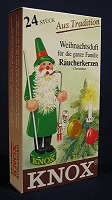All About German Incense
All About German Incense

Incense has literally been around forever. From the earliest ancient civilizations, incense has been prized for its healing and mood-altering qualities. It has been used for religious and spiritual ceremonies for thousands of years and was always considered a highly sought after commodity for trade and used as a treasured gift for kings. Today, German Incense is still used throughout the world for many of the same reasons it has been used for millennia. Of course, without incense we would not be able to enjoy the fun of collecting German smokers, so the history or incense is very important.
Almost since the discovery of fire, man has been burning incense. Everything in nature has its own unique scent and even early man must have realized that burning these natural materials allows these scents to fill the air with aromas that were pleasing to the nose. The sight of the flickering flames, the swirling smoke, and the overwhelming smells that came from burning different woods, leaves, and herbs must have inspired the earliest men to combine these smells into new and exciting combinations for medicinal and spiritual purposes. With the development of religion and the worship of gods, the burning of natural materials for a variety of different purposes became commonplace. Incense was used to please the pagan gods by burning certain scents mixed with ceremonial fires. Incense was also used in order to purify an area in preparation for a religious ceremony or to chase away evil spirits by burning unsavory scents and smells. It was also used for a more practical manner to get rid of nasty smells in living areas, such as those produced by trash, defecation, animals, illness, or death.
Ancient civilizations, such as the Egyptians and Persians, prized incense for its healing properties and was used as a valuable trading commodity. Frankincense, for instance, was much more valuable than gold or silver at the time. Along with special herbs, spices, oils, and powders, incense was considered a gift from god and was used for worshipping purposes. For nearly 1,500 years, the trade of Frankincense flourished throughout the Middle-East and was eventually introduced to the Romans who took on the practice of incense burning, causing its worth to soar. Unfortunately, after the fall of the Roman Empire, the trade of Frankincense nearly disappeared due to the sudden lack of demand and the high taxes that had been attached to incense at the time.
With the rise of Christianity, the use of incense continued to flourish as the Roman Catholic Church used incense during religious ceremonies as a way to symbolize the connection with god and a way to prepare parishioners for worship. Different incenses were burned for use before, during, and after religious ceremonies in order to awaken the spirit of devotion. While many of the Western churches abandoned the use of incense due to its association with pagan ceremonies, the Eastern churches continued the practice of burning incense and continue to do so today. The burning of incense in the Roman Catholic Church still symbolizes the sacredness of prayer, the connection to god, and an expression of devotion to Christ.
The use of incense has also long been used as a way to drive away evil spirits. The ancient Egyptians used incense to purify a worship area by driving away the evil spirits while also attracting the attentions of their gods. Egyptian tombs were filled with large amounts of incense to ensure the body's trip to the afterworld. Frankincense, in particular, was especially popular because it was considered a source of sustenance for the pagan gods. This practice of driving away spirits through the use of incense is still used today, especially during the holidays. The practice of burning incense to chase away evil spirits has been used for hundreds of years in Germany as the result of old superstitions. It was once believed that evil spirits would gather and dwell inside homes and could only be removed during Raunaechte, or the longest night of the year, by making loud noises or lighting candles throughout the house. Once the spirits were gone from the homes, incense would be burned in each room of the house to bless the home and discourage the evil spirits from returning.
This German tradition is still practiced today by lighting German incense and placing German smokers in every room of the house on January 6th during the Festivity of the Three Wise Men. In Germany, Christmas lasts for twelve days, and on this last day of the holiday, the Germans celebrate the gifts of the three wise men: gold, frankincense, and myrrh. German smokers are lit in each room of the house in order to honor the birth of Jesus, but also to drive away the evil spirits or negative energies that may have accumulated in the home throughout the year. The burning of incense is thought to clear the air of negative energies in order to start the new year off with positive energies.
As you can see, the use of incense has a long tradition that is still widely practiced today. While incense is no longer prized as a treasured commodity, it is still as popular as ever. Today, we are no longer limited to the use of just frankincense for our incense burning pleasures. German incense now comes in a variety of scents that can be used in German smokers throughout the year, not just at Christmas. Coconut, coffee, jasmine, lavender, green apples, vanilla, cinnamon, and cedar are just some of the wonderful incense aromas you can enjoy. So, keep those German smokers out all year long so you can take part in a tradition that has literally been around since the dawn of man. Of course, we've come a long way from the ancient fires of history to the whimsical German smokers of today!
